Ground Control -weight shift
Last issue, with the help of my long-time friend and student Morgan Mason, I introduced you to the underlying principles that shape our vision of the modern athletic golf swing based on extensive research and study in the field of biomechanics – the natural movement of the human body. Now we’re going to take things a stage further, with a look at some of the procedures we use in the screening process that enables us to identify a player’s physical capabilities – along with several of my favourite exercises that help a player to improve his body dynamic
By Jean-Jacques Rivet Head of Under armour innovation centre for Europe
Article 1 in this mini series – Le Swing Dynamic
Article 2 in this mini series – Work That Body
Article 3 in this mini series – Ground Control
Over the course of this mini series I have introduced the basics of biomechanics as the study relates to athletic movement in the golf swing. Specifically, we have explored the management of weight shift within the action of winding and unwinding the body, optimising what we term ‘dynamic balance’ for the efficient delivery of clubhead speed and power. When a coach talks about the importance of building a swing ‘from the ground up’, he or she is referring to the unavoidable fact that we play this game with both feet on the ground – at least that’s the theory!
There is simply no escaping the fact that the quality of our footwork, our interaction with the turf, is vital to the chain of movement we enjoy. It is often observed that a talented golfer has ‘good hands’. The inference, of course, is that the player in question has an enviable ability to swing the clubhead and strike a ball with a natural affinity for the technique required to hit a good shot – an intuitive sense of timing, ‘feel’, and so on.
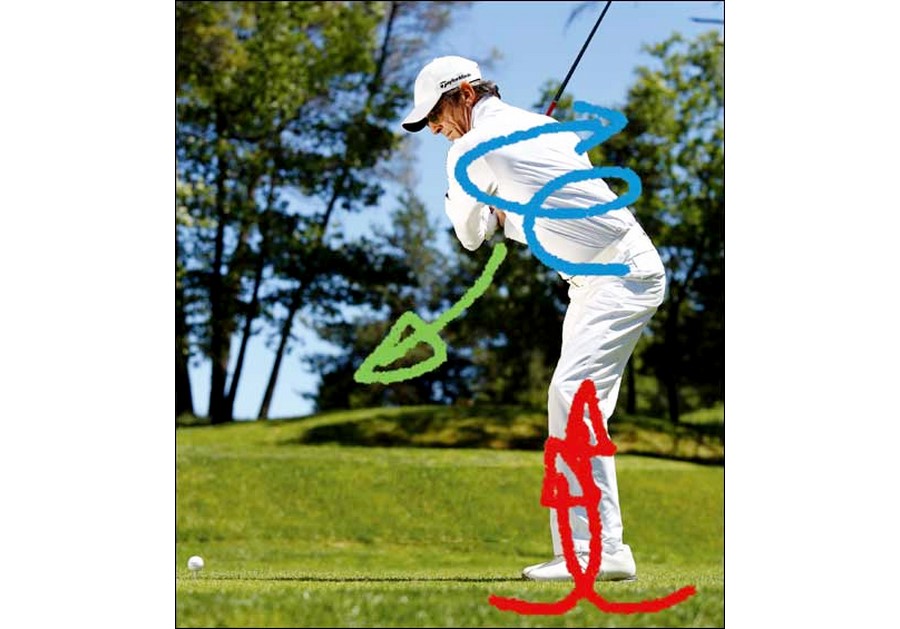
The kinematic sequence is translated into speed as you swing the arms and release the clubhead (GREEN)
Ground Control -weight shift
As a biomechanist, I would extend that observation to suggest that it is also possible to identify players who have ‘good feet’. In fact, golfers who enjoy and exhibit a good hand action, more often than not, also tend to display good footwork. That natural athletic ability is not only evident in the way a player holds and swing the golf club but in the way he or she maintains balance with complementary footwork.
Ground Control -weight shift
So the two physical elements are related – as you’d expect when you stop to consider that the hands hold the club and the feet provide that all important traction with the ground. If a player were to be suspended in limbo, with his feet dangling a few inches off the floor, he would not be able to generate anything like the dynamics required to create coil and clubhead speed. as the only points of contact you have with the turf, the feet play a vital role in anchoring and stabilising the body, providing the physical conditions required to wind up the muscles in the body in the process of creating an effective coil.
In french, we have an expression for sports where you need to use the feet – sport d’appuis. We tend to talk about the golf swing as an entity in its own right, and yet in order to wind up your body and swing the club with real force you need resistance to that rotation…
Which brings us back to the feet: a dynamic swing is all about the body acting and reacting with the ground, drawing energy up from it. There is an inevitable connection between what the feet are doing and what the hands and arms are able to achieve in order to manage the aspect, the behaviour and the acceleration of the golf club.
Over the last few years I have been fortunate to work alongside coach david Leadbetter to further my research into the way in which the chain of movement that we can identify in the swing is related to the athleticism in the lower body – and specifically, the feet. And it’s fair to say the findings have influenced david’s philosophy on the swing every bit as much as they have enabled me to relate biomechanical principles to golf.
Quite simply, the way in which a golfer uses his feet and ankles determines his or her ability to achieve and maintain good posture and dynamic balance, while at the same time facilitating the chain reaction we are looking for in the muscular connection up through the body. The correct positioning of the feet allows the ankles to work in harmony with the respective calf and thigh muscles to maintain the posture in a stable position; that foundation provides the platform over which the upper body is able to wind and unwind to create the core momentum of the swing.
The importance of being ‘grounded’
Those of you who read parts 1 and 2 of this series (Le Swing Dynamic & Work That Body) may recall the concept of weight shift from heel-to-toe along what’s known as the ‘Hendrix bar’, an anatomical term relating to the axis of the foot running from the second toe towards the centre of the heel.
Ground Control -weight shift
When a golfer plants his feet correctly at the set-up he enjoys a sense of engagement with the turf upon which he is standing (good players will often describe to me the sensation of ‘gripping’ the turf through their feet), while at the same time rooting the ankle and the calf muscles in readiness to make an athletic movement.
I want you to have a real awareness of this the next time you work on your technique. Focusing on that sensation of the feet being truly ‘grounded’, really feeling the turf and the resistance it offers, will enable you to establish and then maintain balance in motion as you wind and unwind your body to create a sound, repeating swing.
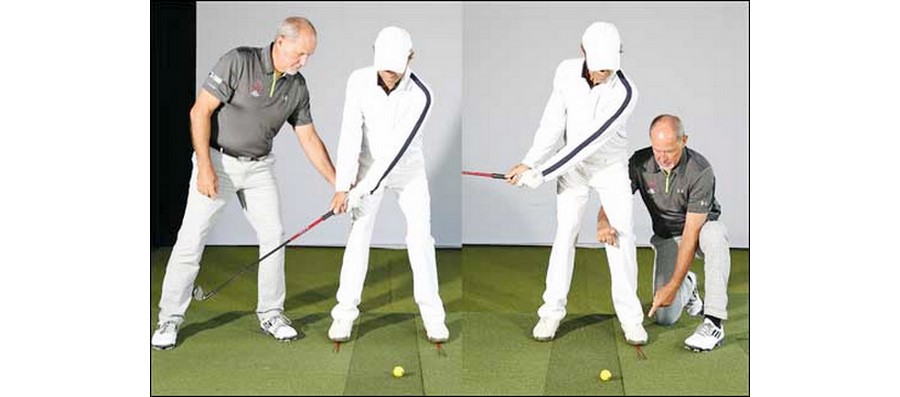
As the arms/hands swing with the direction of your rotation, your weight moves towards the toe of left foot, heel of the right
Ground Control -weight shift

Ground Control -weight shift
This is why hitting balls barefoot is such a great exercise for golfers – it’s something I urge my students to do as often as possible. The experience (literally!) helps you to feel more of the ground for the simple fact there is no interface between your feet and the turf. What’s more, as a coach, watching a player hit shots barefoot enables me to see how a player’s hands and feet work together within the overall context of the swing.
The naked truth, if you like!
[Just taking a club and rehearsing your swing barefoot on the carpet at home will similarly heighten the role of the feet and promote the sensation of your muscular chain resection being drawn up from the ground.]
Taking this a stage further, I always encourage my students to hit balls on the range in bare feet and shorts so that I can see clearly how the ankles, calves and knees work during the swing. And a clear result of this study is that in a good golf swing there are no sudden erroneous (or BIG!) movements – i.e. there is no significant lateral sway or forward lunge into the ball. A sound, repeating golf swing relies on the consistency of a player’s rotation around a stable axis.
In contrast, I see many amateur players who demonstrate excessive weight shift, either rolling to the outside of their shoes or rocking wildly back and forth, to the extent they lose the consistency of that natural rotary motion. When your weight is allowed to move erratically (off the stability of the Hendrix bar) you displace the axis of rotation and struggle with an inconsistent swing path.
In summary, then, it makes sense that the better you are able to manage your weight distribution at the set-up and during the swing, the more consistent your swing will be. This is the message I deliver to all of the players I coach – whether it be my friend and longtime student Morgan Mason, the reigning US Open Champion, Justin Rose, or BMW PGA champion, Matteo Manessero.
The origin of coil – It all comes down to footwork & dynamic balance
2013 US Open champion Justin Rose has one of the most compact & efficient swings in world golf, and this mini-sequence provides us with a wonderful example of the way in which the grounding through the feet determines both the quality and consistency of the coiling process. Pay particular attention to the way Justin negotiates the transition – you can almost feel the pressure that is being exerted down through the right leg into the foot as he shifts gear and readies himself for the burst of acceleration through the ball. In the image just after impact we can see that Justin’s left foot is now coming up as the weight travels towards the left heal, the force and momentum of the swing now irresistible as he releases his energy to the finish, where we find him perfectly balanced, hips and chest facing left of target, supported on the toe of the right foot. Textbook stuff.
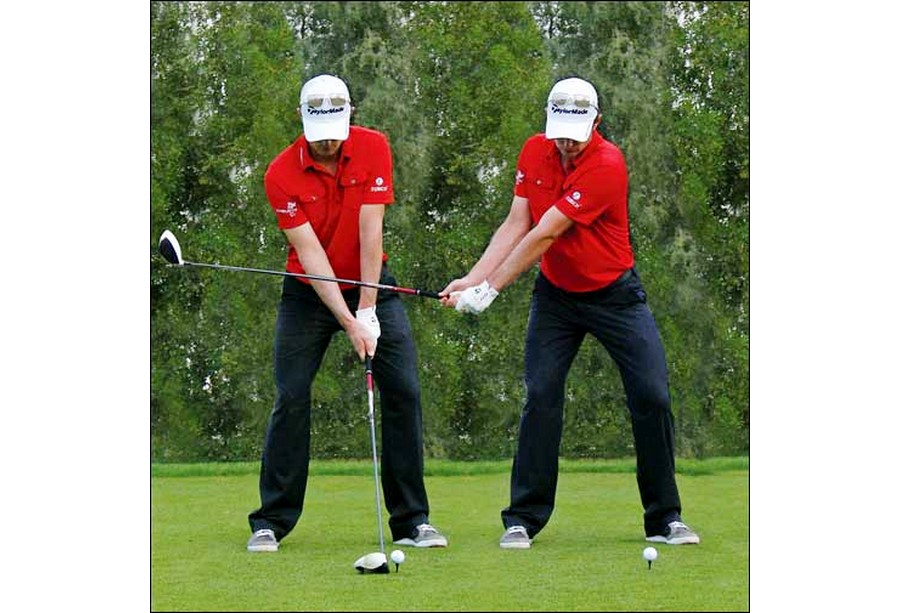
Ground Control -weight shift
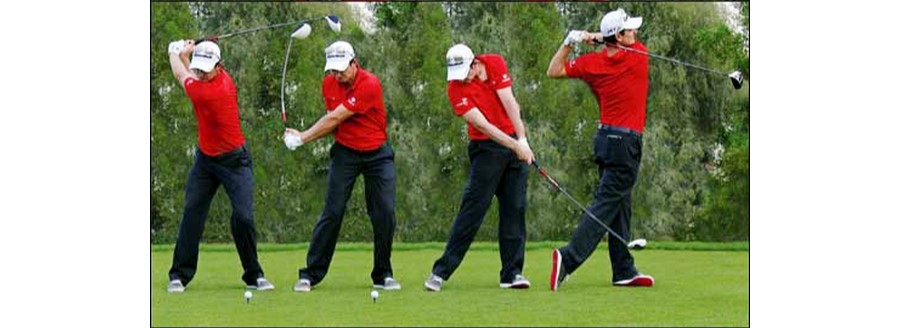
Ground Control -weight shift
Note the position of Justin’s right foot as he shifts into the downswing – while his weight is clearly shifting to the target, his right foot remains planted for a split-second, giving him critical moment to ‘settle’ and allow the arms and the club to fall into position. The left foot, meanwhile, remains planted right up to impact when the forces and momentum cause it to lift as he shifts into the follow-through en route to the finish
The key stages through the swing
So, first things first: let me present a basic understanding of where your weight should be at each of the following distinct phases in the golf swing. The muscular chain starts through the feet, and internalising this information will go some way to helping you feel it when you go out to practice and rehearse your movement. Justin Rose is a useful model.
AT THE SET UP: Assuming a full swing, your weight at the set up should be ‘centred’ in the middle of the feet, thus optimising balance with your body’s centre of gravity – as Justin demonstrates below. A tendency among amateur players is to position too much weight on the front of the feet, which upsets the centre of gravity and has a negative influence on the coordination of the arms and body during the swing. (Rocking back and forth, heel-to-toe, before settling your weight on the middle or balls of your feet will help you to correctly engage the calf and thigh muscles critical to establishing good ‘ready’ posture). The better your balance, the more relaxed you will feel in the arms
HALFWAY BACK: As you work your arms and club with the rotation of the body to the halfway back position (the shoulders turning over the resistance of the lower body to create a stable axis of rotation), so the weight should be moving along the Hendrix bar towards the front of the left foot, and down that same axis towards the heel of the right foot. The left knee/right hip provide resistance to the rotation of the torso – this is correlated with the footwork (i.e. your weight is moving to the front of the left foot, rear of the right).
The point to grasp here is that the direction and the momentum of your arm-swing should reflect the movement of the centre of gravity (CoG). This is something we monitor closely, as this initial link in the chain is key in determining the quality of your overall motion: from the set-up, the CoG runs from a central position towards the right heel (with the hands/arms working in a similar direction).
This is something David [Leadbetter] was quick to pick up on. At the start of the swing, the hands and arms should move with the body following this natural inside path, tracking the weight shift along the Hendrix bar on the right foot. (This was a key element to Nick Faldo’s swing changes back in the early 1980s, helping him repair a tendency to take the arms and the club away outside and independently of the body action).
AT THE TOP: Completing the backswing, your weight is now towards the front of the left foot and deep into the heel of the right. You are fully rotated, fully coiled and ‘loaded up’. The knees and thighs act as shock absorbers, creating that essential resistance to the rotation of the upper half while at the same time providing a balanced, stable platform. A lot of amateur golfers struggle to maintain that resistance in the lower body as they reach the top of their swing. We see players who roll onto the inside of the left foot and/or who lose the flex in the right knee – either way the containment of weight shift is lost. When you suffer this action you diminish the coil – the kinematic sequence is damaged from the ground up.
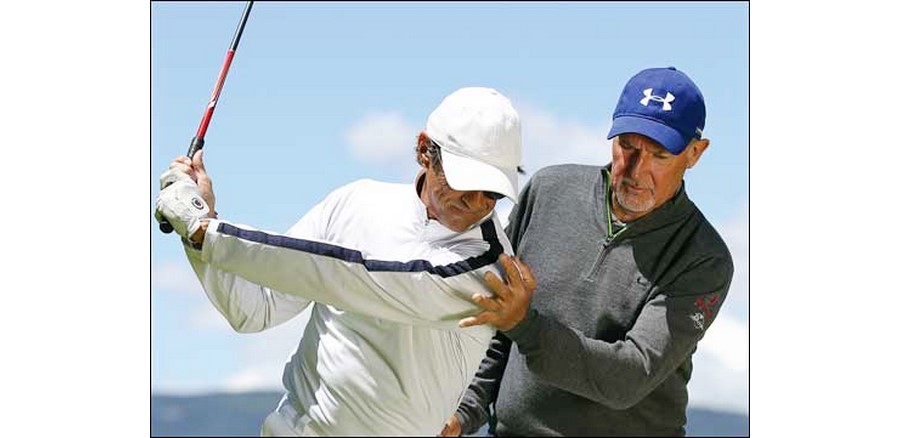
Creating a resistance to the left shoulder has the effect of allowing the weight shift in the lower body to be activated before the bigger muscles in the torso unwind. Remember, the key to a powerful and sequenced downswing is that you unwind from the ground up…
Ground Control -weight shift
STARTING DOWN: The quality of the delivery through impact is determined through the transition period – the critical moments as you reverse your momentum from backswing to downswing. And the key here is that you ‘settle’ into the downswing in readiness to shift through the gears for impact.
Here (and the research is conclusive) we are looking for a moment of calm that allows the gears to mesh in readiness for a burst of acceleration through impact. If you are too quick from the top, you will destroy the second stage of the downswing and fail to create compression on the ball. With the benefit of a force plate, the data tells us that as they unwind to what you might term the predelivery position, the best players in the world still have 50% of their weight on the right side, 50% on the left at mid-downswing. In stark contrast, amateurs are inclined to rush onto their left side to such an extent they could have as much as 70% of their weight on the left foot at this point. (And, as a result, they are not able to maintain their acceleration through impact – in fact, they can often be observed to fall backwards as they release the club, which is actually slowing down as it meets the ball!).
Working with and studying the best players in the world, the capacity to maintain this right foot down position as they initiate the downswing sequence is a shared characteristic. The accompanying images of Justin Rose perfectly illustrate the ‘grounding’ and the calmness golfers of this calibre display in the process of winding and unwinding their swing. Just look at the way the right foot remains planted as he settles and gathers his momentum for the return journey – world class. (The less physically strong you are, the better it is to work on this discipline as you negotiate the transition – the longer you can stay on your right side, and keep that right foot planted, the more time you will have to unwind and maximise your energy in the recoil, accelerating the club for impact.)
THROUGH IMPACT: Golf’s moment of truth – and the figures don’t lie: when we analyse top players on the AboutGolf force plate at the ETPI here at Terre Blanche, we discover a recurring pattern – the weight is now travelling from the front to the back of the left foot (facilitating the rotation and clearance of the hips) with as much as 80% of the player’s weight on the left side as they make contact with the ball.
Again, for many amateurs, the big problem is that the urge to move forward sees the weight move to the toe of the left foot, which makes it impossible to rotate and clear the hips correctly. We like to see the right foot work gently inside as the momentum now travels from heel towards the toe, where it will ultimately finish at the conclusion of the swing.
How to improve your grounding: Simple drills to enhance balance, traction, rotation & stability
In previous articles I have talked about my time working alongside David Leadbetter, and the insights that experience gave me when looking at the mechanics of the swing. Time and again his lessons would come back to the fundamental role of the feet, the ankles, calf muscles and thighs as he impressed upon a player the chain of musculature that determines the quality of the body motion – and its repeatability.
With David’s help we have devised a number of simple drills and exercises that can help golfers of all ages and abilities change the timing and synchronisation of their swing simply by working on their grounding – and, specifically, on that discipline of hanging back at the top of the swing, resisting the temptation to throw yourself into the downswing, waiting for your moment. Where the accomplished player gives himself all the time in the world to negotiate the transition, the amateur is generally way too fast – and in a flash he loses his timing.
The single most important lesson you can take away from this article is that, having drawn up energy from the ground, coiling your body effectively, the discipline of holding on your right side for a split-second as you shift into the downswing is vital to synchronising the arms and body in the change of direction. In so doing, the club remains in balance with the rotation of the body as you then ‘slingshot’ and let it all go in the release through the ball.
This is precisely the lesson I am giving to Morgan (pictured left), holding his left shoulder so as to create a resistance to the upper body that encourages the transition to work from the ground up, thus maximising the recoil effect. Think of the racing driver building up momentum through a fast bend, waiting for the moment to press the accelerator and slingshot on exit – this is exactly what happens in a good golf swing. It’s the secret to effortless speed.
In good posture, if you look at the way the feet are positioned, you will see the weight is directly over the middle of the talus (a bone in the middle of the ankle of the foot). That is the point of strength – you build posture upon it. When the weight is centred in the right way, the muscles in the calf and thighs can be engaged correctly. If the centre of gravity is too much in the front of the foot, the ankle is denied the opportunity to work correctly. Too much tension will be felt in the back of the legs, not enough on the quads, which in the swing prevents the hips rotating and clearing as they should through impact.
The quickest and easiest way to appreciate the sensation of staying grounded and balancing weight along the Hendrix bar is to set up on an alignment cane, running from second toe to the middle of the heel, as you see Morgan doing in the accompanying photos. Rehearsing your swing with your feet centred and balanced on top of the canes will very quickly tell you just how far off it you have been(!), and as you learn to maintain the feet in good posture – which in turn keeps the ankles centred over the foot – so you will eliminate the problem of having your weight fall or roll to the inside or outside of the stick.
Remember, in the backswing, the sensation you want to feel is that of your weight travelling along the Hendrix bar from the middle to the front of the left foot while simultaneously moving along that same axis toward the right heel. On the way down, the direction is reversed; the weight works back along the Hendrix bar toward the left heel, allowing the left hip to clear at speed as the body unwinds for impact. Morgan is working on those very sensations, all the time conscious of staying ‘grounded’ on the cane.
Another drill that has proved particularly beneficial for many of the players I coach – Morgan included – is to use a heavy-duty training band, one end looped around the left shoulder, the other around the right heel. When you alternate rehearsal swings using the canes and this band, you will really feel the benefit of maintaining that right foot grounding as you start the downswing, rotating your left shoulder against the resistance of the right foot for as long as comfortably possible before catapulting to a finish. You want to feel your weight flow into your right heel as you coil the backswing, then hold that position momentarily as you begin to unwind, before releasing the right side through the shot to the finish.
Ideas that will help you to improve dynamic balance
For a simple drill you can rehearse at home or out hitting balls on the range, take two halves of a tennis ball and place them under your left toe/right heel as shown. Once in posture, the idea is to exert downward pressure on the semispheres as your weight flows simultaneously towards the left toe and right heel as you work on your backswing. This will teach you to appreciate the dynamics of correct weight shift in the initial stages of the swing – and set off a chain reaction
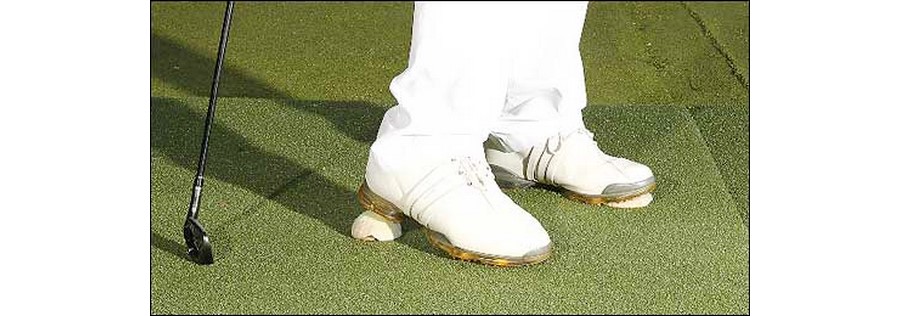
Ground Control -weight shift
Alignment canes provide a useful prop to test just how grounded you are as you work through the stages of your swing. The key is that you maintain that sense of stability with your weight running along the central axis of your feet – the Hendrix bar. Here I am stressing to Morgan the importance of keeping the left foot grounded as the left leg ‘posts’ through the impact area (what you may have heard referred to as hitting against a ‘firm left side’)

Ground Control -weight shift
With the help of a strong rubber training band, the drill you see below is one of my favourites when it comes to impressing on a student the importance of holding that grounded right foot position during the critical change of direction. Loop one end around the left shoulder, the other under your right heel, and make a series of swings with the focus on maintaining that right foot position as you start down – the difference will amaze you…
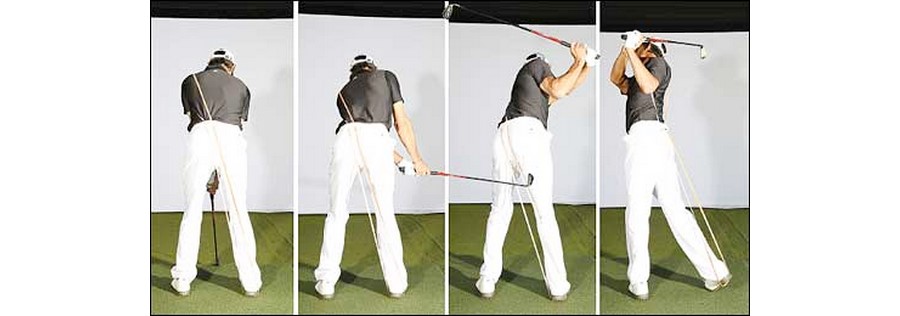
Ground Control -weight shift
For those of you with access to a gym, this exercise is a great all-rounder for developing not only the strength of your core rotary motion in the upper body but the sensation of remaining ‘grounded’, planting the feet and creating resistance in the hips (while at the same time staying in balance!). Keep your feet flat on the ground and this provides a terrific
work-out that will massively help your golf swing

Ground Control -weight shift
Use your noodle! Your lower body is a suspension unit in the golf swing – and the better your balance and stability, the better your swing will be…
Stand in such a way that you get the centre of each foot presing down on the noodle so that you engage the muscles in your ankles, thighs and hips
Brace yourself! Dynamic balance in the lower body enables you to resist
the tension in the band – neither toes nor heels should touch the floor!

Ground Control -weight shift
In good posture, hold a weighted training ball in the palms of your hands while finding your balance – again, neither toes or heels should touch the floor
Working hands, arms and torso together, your goal is to improve your core stability as you rotate, your arm-swing following the direction of your CoG
This exercise gives you the basis of a movement which synchronises the muscles chains while at the same time galvanising the correct relationship between arms and body

Ground Control -weight shift
The inside story… insoles align the feet for better posture & stability
The importance of our interaction with the ground is reflected in the widespread use of insoles in the many different sportsmen and women I work with.
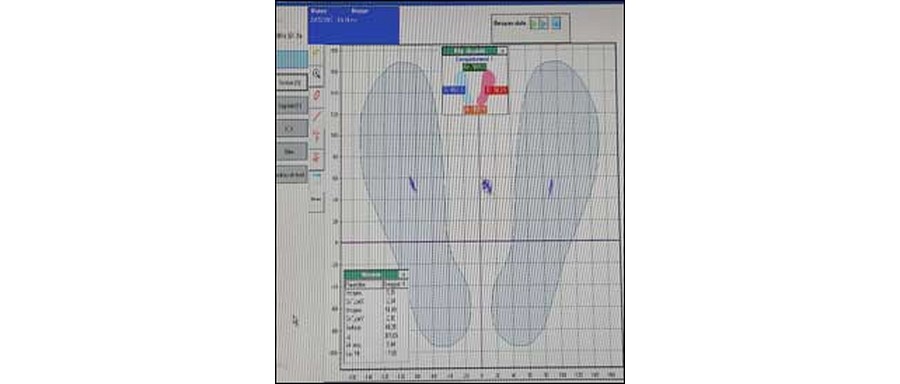
Ground Control -weight shift
From football and rugby to cricket and, yes, golf, a properly fitted insole provides a ‘glove’ that aligns and positions the foot in the optimal position, thus guiding the proper action of the muscular kinetic chain around the skeleton during the swing.
Good posture activates the tibialis anterior – the sensation you experience if you try to curl your toes up inside your shoes (another good exercise being to make swings barefoot, your toes curled up as far as you can get them, as you see Morgan doing above. That engages the muscles you need to provide optimum support in the ankle and thigh.)
Most of the golfers I work with use insoles. Justin Rose has used them extensively in his career. And as a result his feet and ankles are strong and have been well trained in terms of the position they need to achieve to establish and maintain posture (the benefit of so-called ‘muscle memory’). These days Justin is one of a growing number of tour players who prefers the look and feel of softer ‘street’-style shoes, and increasingly the main manufacturers are being asked to develop models that can easily accommodate insoles, which would provide the ideal combination of comfort and practicality.
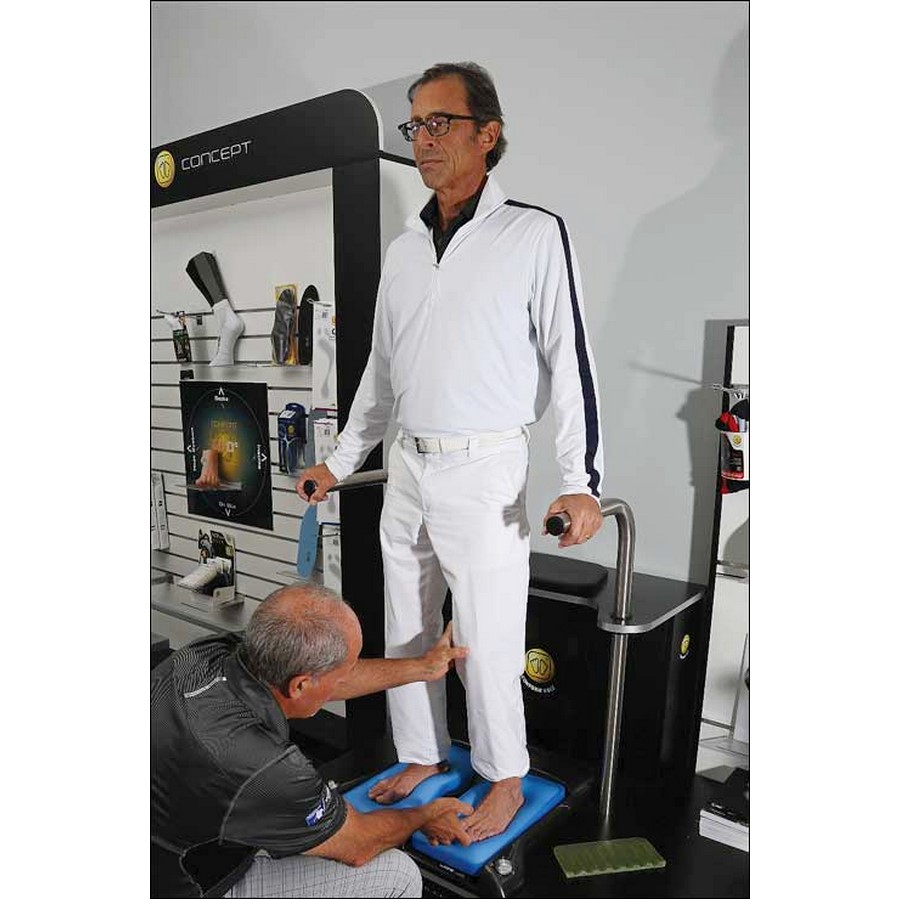
Ground Control -weight shift
My advice to serious amateur golfers is to combine the use of insoles with the various exercises outlined here to train and develop the key muscles that determine the quality of balance and posture. What you have to remember, of course, if that tour players spend hours on the range honing these elements of technique, and they have the athletic ability to repeat it, whether training in bare feet or wearing the soft shoes popular today. A higher handicap golfer does not have this athletic ability, there is less support built in to this type of shoe, and so wearing them is not necessarily good for your golf. So while they may feel comfortable they do not always have benefits.

Ground Control -weight shift
The key when it comes to golf shoes is that when lacing them you are able to feel the pressure between the mid foot and the ground – maintaining that relationship is the key to controlling your weight shift along the Hendrix bar.
In my business, the key word is ‘athletic’: the more your feet are athletic, the more engaged they will be, the better the muscles are able to work, the better your dynamic balance and control of weight shift in the golf swing.
